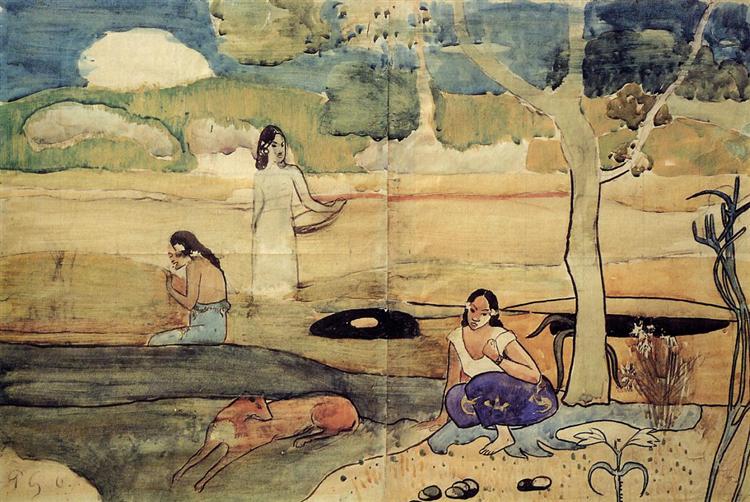Description
In "Tahitian Scene" (1892), Paul Gauguin offers a window to a world where reality and interpretation are intertwined in deeply evocative ways. The work reflects its incessant search for an aesthetic that transcends the limits of mimetic representation, approaching an art form that resides in emotion and symbology. The painting is inscribed in its period in Tahiti, a decisive chapter that significantly influenced its style and conceptualization of art.
Visually, the composition is characterized by a peaceful disposition that invites the viewer to contemplate. In the center of the work, two human figures, presumably Tahitianas, emerge from an lush environment that combines elements of nature with an almost dreamlike approach. The figures are covered in subtle tones that contrast with the vibrant background of the scene. On the left, a woman is sitting in a posture that evokes tranquility, while on the right, another figure seems to look towards the viewer, establishing a tacit dialogue that enriches the visual experience. This type of interaction between the figures and the observer is a recurring theme in Gauguin's work, where the subject's look invites a more active participation of the viewer.
Color is one of Gauguin's most powerful allies in this work. Vermellones and gold tones predominate in the landscape and in the clothing of the figures, contrasting with the greenery of the vegetation and the turquoise nuances that suggest the presence of the sea. This vibrant palette is not simply a reproduction of nature, but an emotional interpretation that reflects Gauguin's perception about life in Tahiti. The chromatic elections are calibrated to evoke sensations, yearnings and the very essence of a place that he idealized as a paradise away from the materialism of European life of the late nineteenth century.
The fusion of the human and the natural is another fascinating aspects of "Tahitian scene". The figures seem to emerge from the environment, as if they were inextricably linked to the earth, the water and the air that surrounds them. This harmonious connection not only represents a lifestyle, but also reflects Gauguin's search for a deeper meaning, anogen that transcends mere visual representation and addresses issues of spirituality and connection with the essence of life.
Within the context of the work, it is interesting to consider Gauguin's approach on idealism against reality. Although an idyllic image of the Tahitian culture and its surroundings are presented, there is also a layer of complexity that slides below the surface. Gauguin, on his trip to Tahiti, sought to escape the conventions and tensions of European life, but its idealization of paradise can also be interpreted as a form of visual colonialism, where the elements of a foreign culture are selected and presented through Your own lens.
"Tahitian scene" represents more than a simple capture of a moment; It is a testimony of Gauguin's desire to explore new artistic and emotional realities. Surrounded by the beauty that inspired him, he managed to weave a visual narrative that continues to speak of the human search for connection, meaning and beauty by transferring time and history. The work is not only at the intersection of the real and imagined, but highlights the technical expertise and the deep sensitivity that characterize the legacy of the master postimpressionist. His stay in Tahiti was a period of revelations and experimentation that left an indelible imprint in modern art, making it a key element to understand the development of the artistic expression of the twentieth century.
KUADROS ©, a famous paint on your wall.
Hand-made oil painting reproductions, with the quality of professional artists and the distinctive seal of KUADROS ©.
Reproduction service paintings With a guarantee of satisfaction. If you are not completely satisfied with the replica of your painting, we refund your money 100%.

